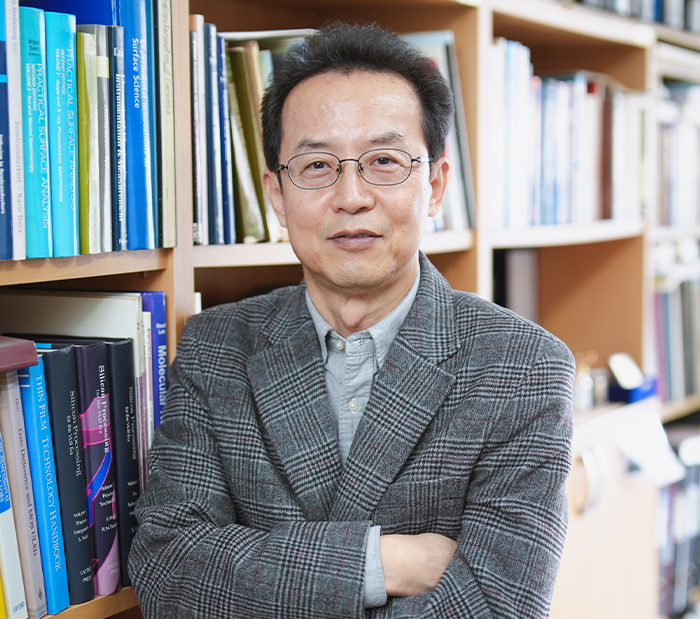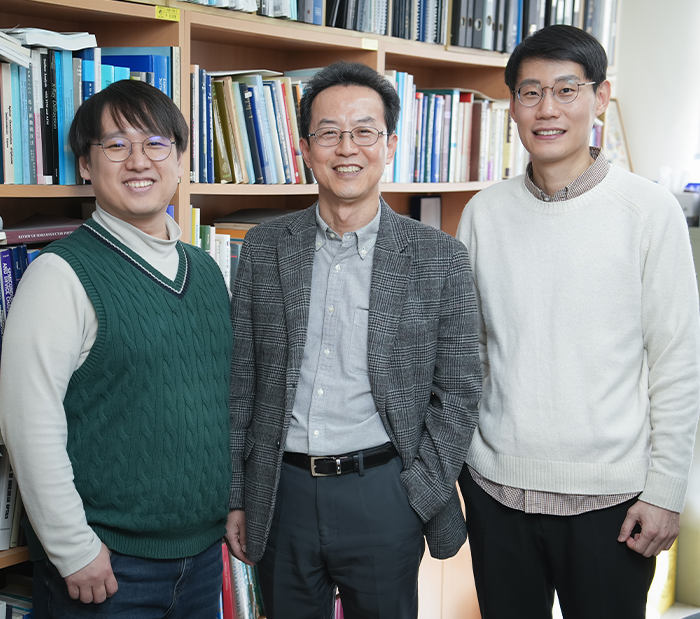Predicting and demonstrating of hidden metastable phase in transition metal oxide
Advanced Materials Science and Engineering LEE, JAICHAN Prof. · Bongwook Chung
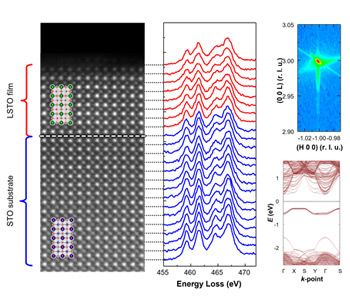
-
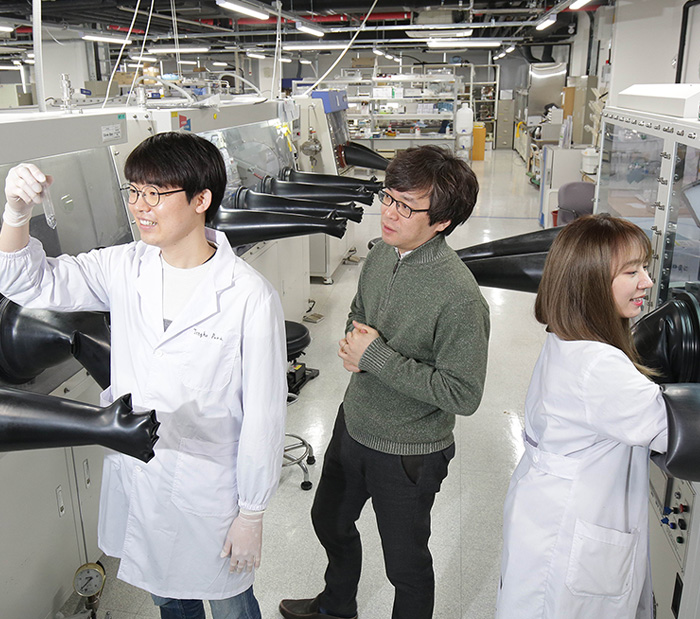
Chemical Engineering PARK, HOSEOK Prof.
Development of Omnidirectionally Stretchable and Transparent Graphene Electrodes
Stretchable and transparent electrodes have been developed for applications in flexible and wearable electronics. For customer-oriented practical applications, the electrical and optical properties of stretchable electrodes should be independent of the directions of the applied stress, and such electrodes are called omnidirectionally stretchable electrodes. Prof. Ho Seok PARK reported a simple and cost-effective approach for the fabrication of omnidirectionally stretchable and transparent graphene electrodes with mechanical durability and performance reliability. The use of a Fresnel lens-patterned electrode allows multilayered graphene sheets to achieve a concentric circular wavy structure, which is capable of sustaining tensile strains in all directions. The as-prepared electrodes exhibit high optical transparency, low sheet resistance, and reliable electrical performances under various deformation conditions. Furthermore, computer simulations have also been carried out to investigate the response of a Fresnel lens-patterned structure on the application of mechanical stresses. This study can be significant to a large variety of potential applications, ranging from stretchable devices to electronic components in various wearable integrated systems. The research was conducted with the support of CAP business and published in one of the most world renowned research papers ACS Nano.
- No. 30
- 2018-07-05
- 1729
-
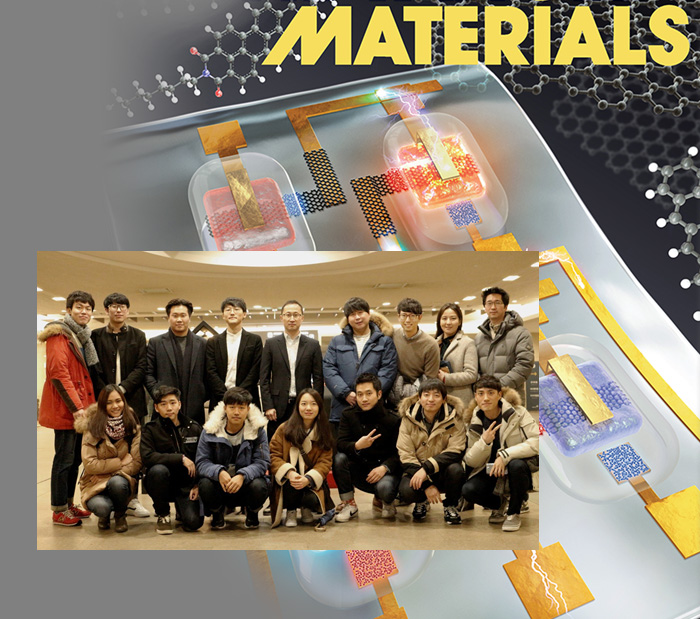
Energy Science KIM, SUNG WNG Prof.
Discovery of new magnetic electride materials
Electro-Active Energy Material Lab. of the Department of Energy Science studies various materials related to energy conversion, magnetism, catalyst and electronics. They are targeting the first discovery and global-top performance in electrides as new electro-active materials and focusing on the development of record-high performance thermoelectric energy conversion materials. Also, they are studying low-dimensional transition metal dichalcogenides from fundamentals to applied researches. Followings are the main research topics: 1. Electrides: Electrides are ionic compounds in which electrons act as anions occupying interstitial real space of crystal structures, not orbitals. Because the electrides show a low work function and high electron concentration, the materials are of interest for electronics and catalysts. The research team designs and synthesizes new electrides by theoretical and experimental researches for industrial applications. 2. Thermoelectric materials: Thermoelectric materials can convert electricity to heat and vice versa. Utilizing the Seebeck and Peltier effect, thermoelectric refrigeration and power generation are possible to enable efficient energy consumption. The team is developing a world-record high performance in state-of-the-art materials by studying fundamental material physics and material process. 3. Low-dimensional materials: The low-dimensional transition metal dichalcogenides utilizing a high quality single crystal and epitaxial thin film are fabricated in their laboratory. Beyond graphene, the research team explores a new two-dimensional crystal structure distinct from conventional layered structures.
- No. 29
- 2018-07-05
- 1628
-
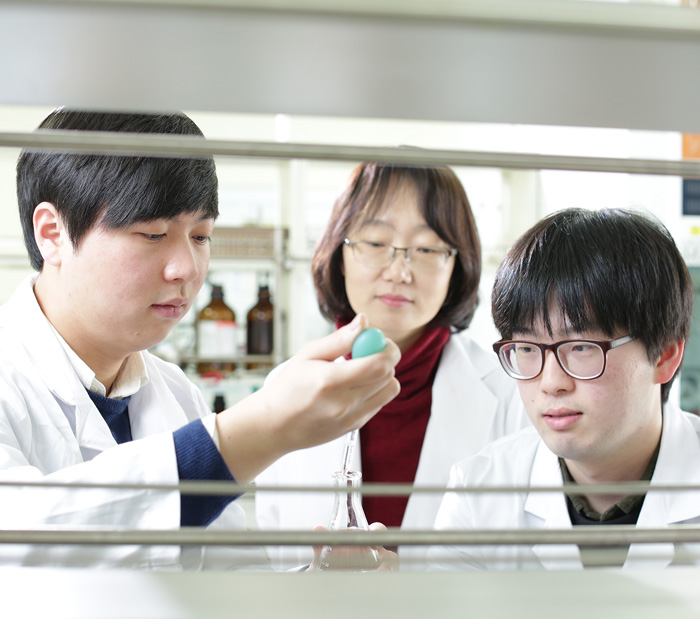
Chemistry YUN, JAESOOK Prof.
Development of a copper-catalyzed method for the synthesis of highly enantioenriched alkylboron compounds
As organoboranes are valuable reagents in organic synthesis due to their versatility in functionalization, the demand for stereochemically well-defined organoboronates is increasing. In general, the creation of simple secondary alkylboron compounds with high enantiocontrol presents a greater challenge than the production of boron compounds with a biasing or directing substituent. Recent approaches to the synthesis of organoboron compounds by copper-catalyzed allylic substitution is the installation of the C−B bond using a diboron or 1,1-diborylalkanes as the organometallic component. All of these methods discard one B moiety from the diboron starting materials during activation and require the use of stereochemically well-defined prochiral allylic electrophiles. Herein, Prof. YUN reports a highly enantioselective synthesis of homoallylic alkylboron compounds starting from easily preparable alkylboron compounds, by tandem addition of B-α-chiral organocopper species to allyl phosphates. The keys to successful transformation are (1) highly regio- and enantioselective hydrocupration to borylalkenes and (2) subsequent asymmetric C−C bond formation with high efficiency. They believe this protocol provides easy access to chiral secondary homoallylic alkylboron compounds and efforts to expand the use of B-α-chiral organocopper species in catalytic bond formations are currently underway.
- No. 28
- 2018-07-05
- 1767
-
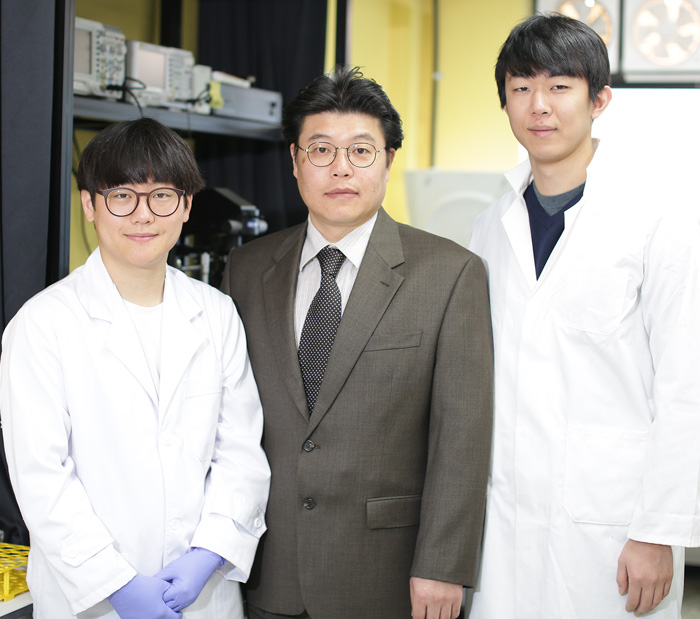
Chemical Engineering KIM, DONG HWAN Prof.
Simple and Disposable Biosensors for Point-of-care Applications
Nanoparticle polymer composites have wideranging applications in fields such as catalysis, optoelectronics, drug delivery and biochemical sensing. In recent years, the use of noble metal nanoparticle polymer composites for plasmonic sensing has attracted much attention, including several fabrication methodologies for such nanocomposites for the development of a substantial collection of plasmon-active sensing devices. One of the greatest advantages of nanoparticle polymer composites on solid substrates is their convenient utilization in practical applications, as they can be readily produced on gold and silicon substrates, glass, and even paper. This makes them more suitable than solution phase nanoparticle polymer composites for device integration, bringing them closer to commercialization and consumer use. To facilitate rapid technology transfers in the near future, an in-depth understanding of the subject matter as well as an update of the state-of-the-art is therefore necessary. The research team describes the assembly techniques used to obtain such nanoparticle polymer composites and their applications in plasmonic sensing based on localized surface plasmon resonance (LSPR) and surface enhanced Raman spectroscopy (SERS). Scheme 1 : Several general configurations of metal nanoparticle polymer composites discussed including nanoparticles (I) immobilized on a thin polymeric film adsorbed or spin-coated on a substrate, (II) three-dimensionally distributed within a polymer gel matrix, (III) adsorbed on polymer brush grafted-to or -from the substrate, (IV) infiltrated within the brush, (V) decorated on polymer fibers electrospun on the substrate and (VI) decorated on free-standing polymer fibers. Scheme 2 : Assembly of nanoparticles on substrate-bound polymers, categorized according to their level of mobility with respect to the underlying substrate. The nanoparticles are categorized as (I) fixated, (II) semi-fixated and (III) non-fixated.
- No. 27
- 2018-07-05
- 1705
-
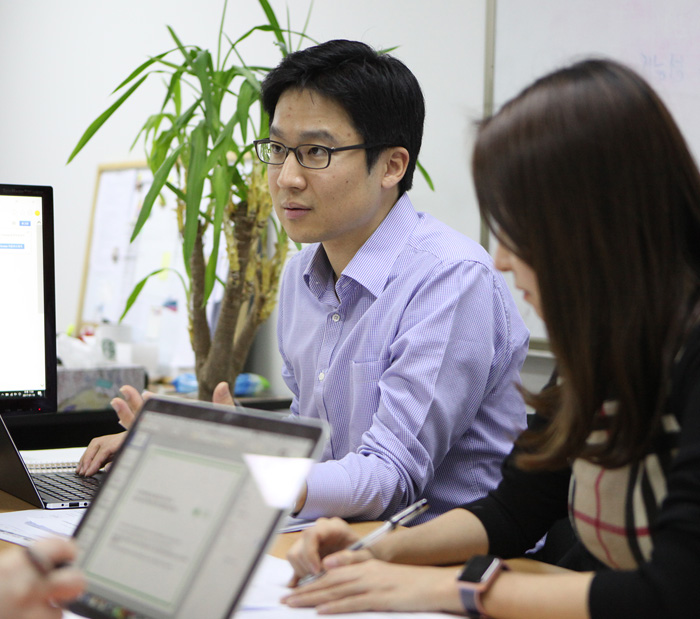
Interaction Science LEE, DAEHO Prof.
Successful Market Strategy of OTT Services based on Analyzation of Consumers
With the emergence of over-the-top (OTT) services, consumers can enjoy broadcasting contents using personal computers, smartphones, and tablets whenever and wherever they want. Not only are traditional broadcasting service providers entering the OTT service market, but Internet service providers are making the move too, leading to competition with each other to achieve market power. A team led by Prof. LEE of SKKU estimated consumers’ preference for OTT services based on conjoint survey data, and conducted a market simulation based on the estimation result, in order to analyze the change of market penetration ratio in accordance to the change of market strategy of each broadcasting service provider. As a result, consumers have the highest priority for real-time broadcasting. When the terrestrial television broadcasting service provider does not provide its contents to other service providers, internet service providers and pay TV service providers can increase their market power by decreasing the price and by increasing the number of VODs respectively. This study was published in the journal Technological Forecasting and Social Change in November 2016.
- No. 26
- 2018-07-05
- 1687
-
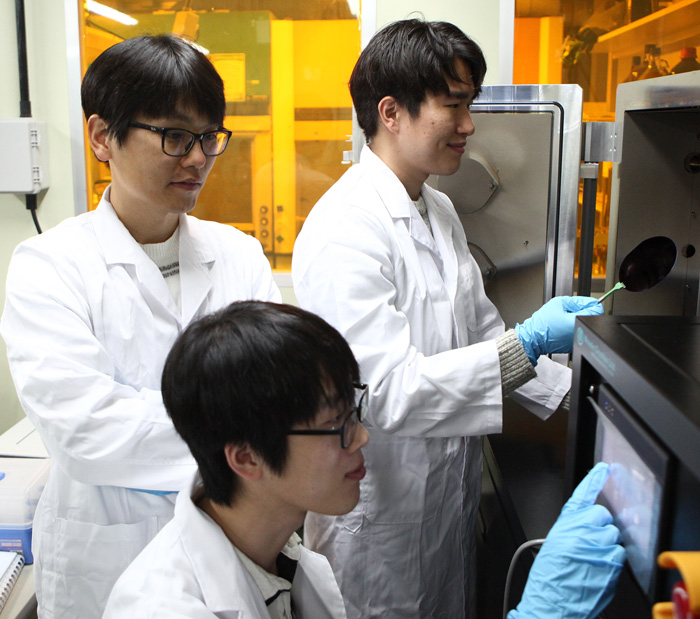
Electronic and Electrical Engineering PARK, JIN HONG Prof.
Development of the Negative Differential Resistance Device for Multi-valued Logic
SKKU research team led by Prof. Jin Hong PARK successfully developed a technology for negative differential resistance devices and demonstrated a ternary inverter as a multi-valued logic application. Recently, negative differential resistance devices have attracted considerable attention due to their folded current–voltage characteristic which presents multiple threshold voltage values. Because of this remarkable property, studies associated with the negative differential resistance devices have been explored for realizing multi-valued logic applications. This study demonstrated a negative differential resistance device based on a phosphorene/rhenium disulfide (BP/ReS2) heterojunction that is formed by type-III broken-gap band alignment, showing high peak-to-valley current ratio values of 4.2 and 6.9 at room temperature, and 180 K respectively. Also, the carrier transport mechanism of the BP/ReS2 negative differential resistance device is investigated in detail by analyzing the tunneling and diffusion currents at various temperatures with the proposed analytic negative differential resistance device model. Furthermore, they demonstrated a ternary inverter as a multi-valued logic application. This research of a two-dimensional material heterojunction is a step forward towards future multi-valued logic device research. The result of the study was published in Nature Communication on Nov 7th with a thesis titled: “Phosphorene/Rhenium Disulfide Heterojunction-based Negative Differential Resistance Device for Multi-Valued Logic.”
- No. 25
- 2018-07-05
- 1992
-
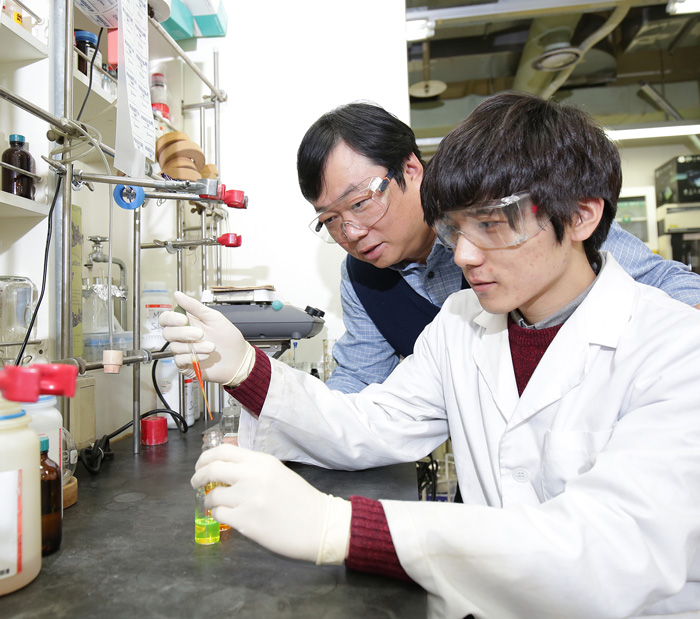
Chemistry RYU, DOHYUN Prof.
SKKU Professor and Team Develop Thin Film Solar Cells with High Efficiency using Pure Organic Dye
A team led by Prof. Do Hyun RYU (Dept. of Chemistry) successfully synthesized new indoline dyes which are pure organic materials, and by applying those to the thin film dye-sensitized solar cells with the thickness of the photoactive layer is less than 2 micrometers (μm), they achieved the world’s highest solar energy conversion efficiency of 9.1%. Dye-sensitized solar cells with transparency, flexibility, various colors, and indoors application capability have received many researchers’ attention, because it can be used for many applications including building integrated photovoltaic systems (BIPV). “The significance of this study is a development of new organic dye-sensitized solar cells with high efficiency at thin films. The research also presents a direction to the design of a new organic dye structure by identifying how the length of the alkyl chain attached to an organic dye which has a plane structure, affects light energy conversion efficiency”, said Prof. RYU. This study was conducted in collaboration with Prof. Tae Hyeok KWON and his team from Ulsan National Institute of Science and Technology, and published as a cover page in the Advanced Functional Materials on Oct. 10th with the title of “Photoactive Thin Films: Indoline-Based Molecular Engineering for Optimizing the Performance of Photoactive Thin Films.”
- No. 24
- 2018-07-05
- 1677
-
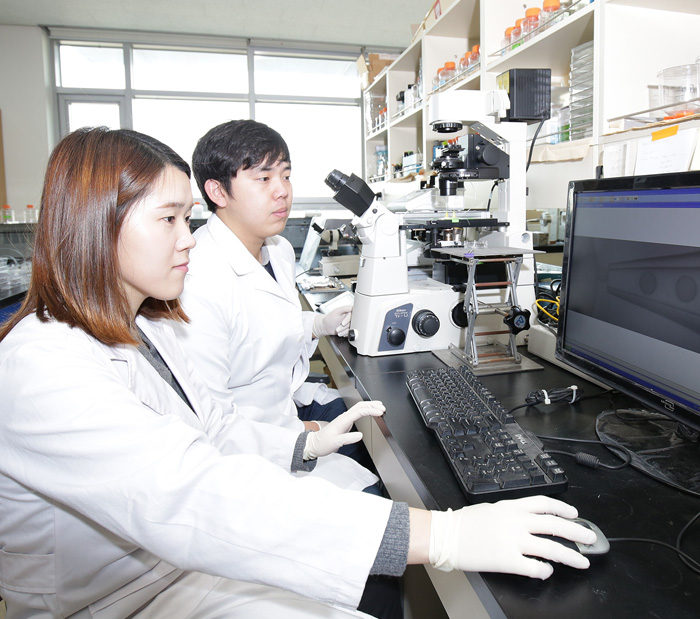
Chemical Engineering YOO, PILJIN Prof.
Microfluidic Generation of Monodisperse for Floral Iridescence-inspired Structural Colorization
Encoding of structural colors in microparticles has undergone significant progress especially by confined colloidal or liquid crystal self-assembly; nevertheless, the use of these previous approaches related to confined colloidal selfassembly, have been prominently limited to 3D optical effects such as Bragg diffraction and Anderson localization. Meanwhile, various natural organisms including flowering plants (e.g.,Hibiscus Trionum flower) have advanced their colorization strategies to divide incoming white light into the spatially sequenced vivid colors, especially by using 2D grating diffractive motifs which is conformably confined onto the curvature (i.e., floral iridescence). In the work published in Advanced Materials they conceived a new idea for the artificial approach to mimicking this wonderful biological strategy and its practical application to the color encoding of colloidal particles. In particular, the monodisperse and smooth surface of photoreconfigurable microspheres produced by microfluidic technique, was deterministically textured with diverse surface relief gratings by means of “holographic photofluidization (see review paper: S. Lee et al., Adv. Mater., 24, 2069 (2012))”; the relevant optical phenomena curved surface-confined grating diffraction inspired by floral-iridescence, have been firstly detailed. Above all, it will act as an important role in greater labeling diversity of colloidal particles and better model of biologically inspired engineering not only for colloidal patching, but also for rational molding of light-flow.
- No. 23
- 2018-07-05
- 1708
-
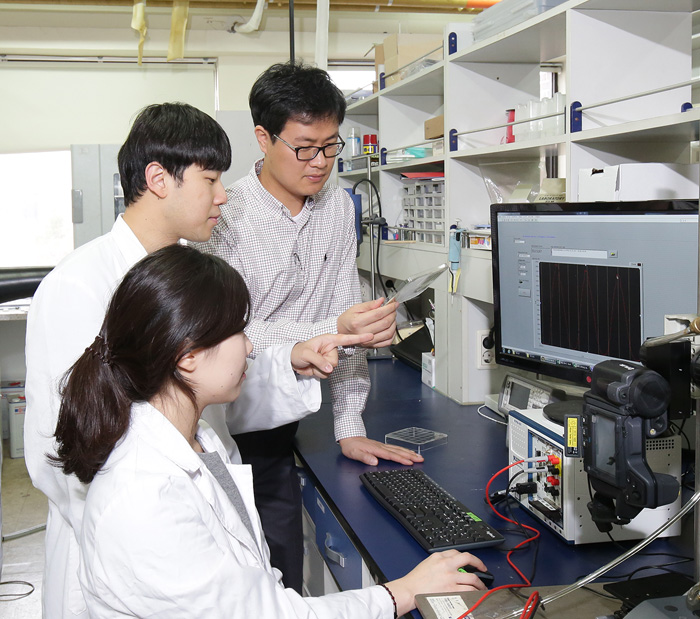
Chemical Engineering KIM, TAE IL Prof.
Future Electronic Devices
Multifunctional Soft Electronics Lab. (Principle investigator; Prof Tae-il Kim; School of Chemical Engineering/Department of Biomedical Engineering/Graduate School of Human ICT Convergence) is studying next-generation electronics; flexible electronics, biomimetics and bio-integrated electronics which have recently attracted attention globally. In particular, the lab are leading worldwide in related research on brain penetrating electronics (Science, 2013) and spider's sensory receptor inspired electronics (Nature 2014). The research themes of the laboratory are as follows: 1. Nanofabrication Lithography in the semiconductor industry is the most important technique, and forming small patterns is indispensable for deriving low cost, high element characteristics. This laboratory is using an unconventional method instead of light illumination. It instead utilizes a polymer mold to form a nanoscale pattern sat low cost by utilizing various natural forces (such as capillary force, adhesiveness, surface tension, etc.). We have announced a large number of patents and papers every year, including ACS Applied Materials and Interface (7, p8070, 2016). 2. Biomimetics We are imitating various natural structures with the nanofabrication technique we accomplished and aim for engineering reproduction of the unique properties. In particular, it was confirmed that adhesive strength increased several hundred times or more by mounting a gradient cilia structure of Gecko Lizard (Foot), Advanced Materials 21,p 6575 (2009). In addition, we developed nano-crack based sensors by spiders (Nature 516, p222 (2014)) and showed that it can be applied to wearable electronic devices, especially by voice signal. 3. Flexible Electronics Flexible semiconductors utilizing organic materials have been receiving the spotlight recently. However, the material itself has the disadvantage of being easy to oxidize, and there are limitations to realizing the high characteristics required in the present era. This laboratory have unique techniques for assembling inorganic thin film devices on a sheet of plastic without device degradation. High performance inorganic electronics on flexible templates can be achieved. 4. Bio-integrated Electronics We are conducting research on bio-electronics that can adhere to human skin or be inserted into the brain and organs. They can measure nerve signals or stimulate the brain with electronic devices. (Science 340, p211 (2013)). This has recently become an important starting point for the fusion research of Neuroscience and Engineering. Research on devices related to melting and disappearing in the body after operating for a certain period of time is ongoing.
- No. 22
- 2018-07-05
- 1727
-
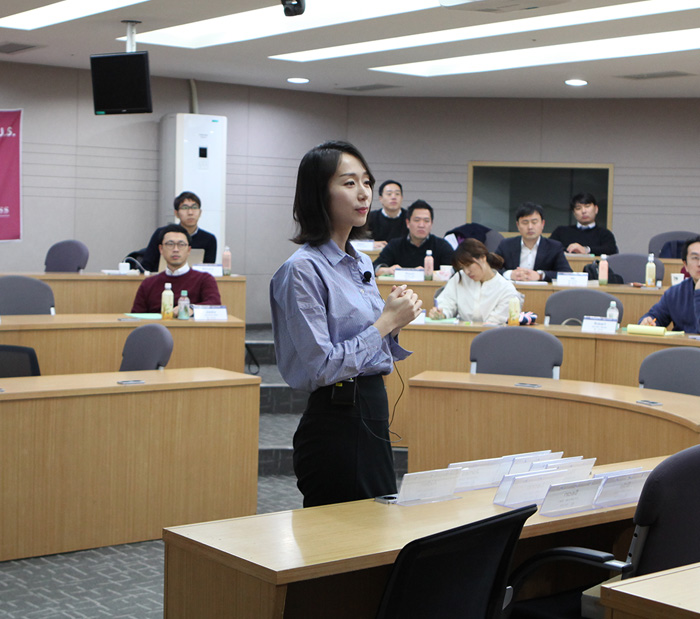
Graduate School of Business Administration KOO, MINJUNG Prof.
자신을 나누어 헌신과 관용의 가치를 얻는 ‘Self-Giving’
‘기부’는 사전적으로 자신의 소유한 것을 다른 사람들에게 주는 것을 뜻한다. 하지만, 기부는 그 내용이나 방법에 따라 기부자가 그 기부가 얼마나 자신을 표현하는가, 즉 자신의 “에센스”를 담고 있다고 느끼는지가 달라진다. 예를 들면 혈액이나 장기를 기부한다거나, 의복과 같은 소유물을 기부하는 것은, 비슷한 가치의 돈을 기부하는 것보다 훨씬 본인의 “에센스”를 담고 있어, 보다 “자신을 나누는 행동” (Self-Giving)이라고 느낀다. 또한, 본인의 이름을 적어 기부하는 청원 운동 참여도, 이름 없이 그냥 ‘좋아요’ 클릭을 하는 것보다 훨씬 본인의 “에센스”가 담겨있는 기부 행동이라고 사람들은 느낀다. 본 연구는 이러한 본인의 에센스를 담은 특별한 형태의 기부인 “Self-giving”이 다른 형태의 기부에 비교했을 때 기부자에게 어떻게 다른 경험과 결과를 가져오는지를 연구하였다. 연구팀은 self-giving이 기부자로 하여금 1) 스스로가 더 너그럽고 관용적인 사람(generosity)으로 느껴지게 하고; 2) 또한 그 기부에 헌신적인(commitment) 사람으로 느껴지게 한다고 주장한다. 즉, 헌혈을 한 사람은 비슷한 가치의 돈을 기부한 사람보다 본인이 더 관용적인 사람이며 더 헌신적인 사람으로 느낀다는 것이다. 왜 그럴까? 이는 첫째, self가 내재되어 있는 기부의 경우 그 기부가 더 주관적으로 가치 있다고 여겨지기 때문이다. 예를 들어, 사람들은 본인이 오랫동안 소유를 한 물건일수록 그 물건이 더욱 가치가 있다고 여긴다 (예: 오래 소장한 반지). 본인의 기부가 더 가치 있다고 느끼기 때문에 기부자 스스로 본인이 더 관용적인 사람이라고 느끼게 되는 것이다. 둘째, self-giving은 자연스럽게 기부자와 기부, 또한 기부자와 기부대상간의 연관성을 높여서 본인이 더 기부하는 행동과 기부 대상과 깊은 연관이 있다고 느끼게 하기 때문이다. 예를 들어, 혈액을 기부하는 행동을 통해, 기부자는 스스로 기부행동과 기부대상과 밀접하게 연관되어 있다는 self-concept을 형성하게 되어, 더 헌신적인 사람으로 느끼게 되는 것이다. Self-giving은 이와 같은 헌신과 관용의 가치 증대를 통해 결국 장기적으로 기부자가 첫 기부 후에도 계속적으로 기부를 하게 하는 원동력이 될 수 있다. 본인이 관용적이고 헌신적인 사람이라고 느낄 때 사람들은 이렇게 변화된 자아 개념 (self-concept)에 부합하는 행동을 하게 되는 경향이 있기 때문이다. 본 연구는 이와 같은 Self-giving의 효과를 연구하기 위해, 장기 VS 단기 소유물의 기부, 기명 VS 무기명 서명, 헌혈 VS 금전 기부 등 크게 세 가지로 나누어 실험 연구를 진행하였다. 장기 소유물 VS 단기 소유물 ‘아프리카 아동들에게 펜 보내기’ 사람들은 본인의 소유물이 자신을 나타낸다고 믿는다. 더 오랫동안 소유를 한 물건, 즉 self가 더 연관되어 있는 물건을 기부할 때, 어떤 효과가 나타날까? 본 연구팀은 103명의 한국 대학생들을 상대로 소비자 조사를 실시하였다. Self-giving의 정도 (즉, 기부가 얼마나 self에 연관되어 있는가)를 조작하기 위해, 펜을 소유한 시간을 조작하였는데, 구체적으로 한 집단의 참가자들에게는 조사 시작 전 펜을 선물로 주고, 다른 집단의 참가자들에게는 조사 종류 후 펜을 선물하였다. 조사 종료 후에는 모든 참가자들에게 아프리카 어린이들에게 펜을 기부하는 캠페인을 소개하고 본인이 선물 받은 펜을 기부할 것을 권유하였다. 그 결과 조사 전에 선물 받은 펜을 기부한 참가자들이 (즉, 보다 오랜 시간 펜을 소유했었던 참가자들) 조사 후에 받은 펜을 기부한 사람들에 비해 스스로를 더욱 헌신적이며(Commitment)과 관용적인 사람이라고(Generosity) 평가하였다. 서명 운동: 기명 VS 무기명 서명 장애인 고용 촉진을 위한 ‘장애인 판매 과자 구매 및 서명 운동’ 소아 환자를 위한 ‘병원 학교 설립 서명 운동’ 본인의 아이덴터티를 가장 잘 나타내주는 것 중에 하나가 이름이다. 따라서, 이름을 기부하는 것, 즉 서명에 참여한다 던지, 이름을 적은 메세지 카드를 함께 기부하는 등의 행동은 Self-giving의 전형적인 예라고 할 수 있다. 연구팀은 위캔 (WECAN)의 장애인 고용 촉진을 위한 ‘장애인 판매 과자 구매 및 메시지 적기 캠페인’과 병원 내 어린이 환자를 위한 ‘병원 학교’ 설립 서명 캠페인을 실시하여, 기명과 무기명 두 가지 경우로 나누어 참가하게 하고, 기부 후 기부자 스스로가 어떻게 느끼는지에 대해 비교 분석하였다. WECAN의 메시지 적기 운동과 병원 학교 설립 서명운동 모두 신원을 밝히면서 메시지를 남기거나 서명한 참가자들이 무기명으로 참가한 참가자들보다, 스스로를 더 헌신적이고(Commitment) 관용적인(Generosity) 사람으로 인식했다. 병원 학교 설립 서명운동의 경우, 참가자들에게 후속 서명에 참여할 의사를 물어보게 되는데, 본인의 신원을 밝히고 이름을 서명한 경우, 차후에 진행될 후속 서명 운동에 참여도가 무기명으로 서명한 참가자들 집단보다 20%가 더 높아졌다. 즉, 본인을 헌신적으로 관용적인 사람으로 인식하게 되면서 이렇게 긍정적으로 변화된 자아 개념에 부합하는 행동을 하게 되는 것이다. 헌혈 VS 금전 기부 신체의 일부를 기부하는 헌혈은 대표적인 self-giving의 예이다. ‘헌혈’을 했다고 상상한 참가자들과 동등한 가치의 현금을 기부했다고 상상한 참가자들을 반응을 비교하였을 때, 헌혈의 경우 참가자들을 스스로를 더 헌신적(Commitment)이고 관용적(Generosity)이라고 인식하였다. 본 연구는 이렇게 다양한 self-giving의 형태를 비교 연구하여 기부자가 오래 소유한 물건, 혈액과 같은 기부자의 신체의 일부, 또한 기부자의 정체성을 드러내는 이름 기부와 같이 기부자와 밀접한 관련이 있는 기부의 형태가 기부자의 자아개념을 보다 긍정적으로 바꾸어, 궁극적으로 지속적인 기부의 효과를 높이는데 도움이 되는 것을 알려준다. 스스로를 관용적이고 헌신적인 사람으로 인식하는 것, 이것이 한번의 기부로 끝나지 않고 지속적으로 그러한 사람이 될 수 있는 기회를 제공하는 중요한 열쇠가 되는 것이다. 이 연구는 2016년 2월 Social Psychological and Personality Science 지에 게재되었다.
- No. 21
- 2018-07-05
- 2654
-
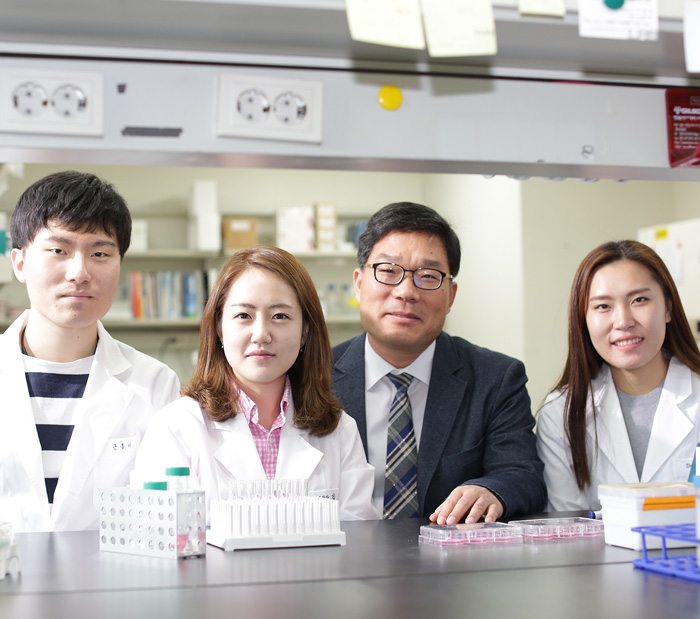
SKKU Advanced Institute of Nano Technology LIM, YONGTAIK Prof.
A Techonology for Enhancing Dendritic Cell-based Cancer Immunotherapy
In recent preclinical and clinical studies, the efficacy of dendritic cells (DCs)-based immunotherapy has been limited by the lack of efficient antigen loading, maturation, and poor migration rate toward lymph node of DCs. The well-designed activation of DCs by enhancing the delivery of antigens and immunostimulatory adjuvants into DCs is a key strategy for efficient cancer immunotherapy. Antigen-antibody immune complexes (ICs) are known to directly bind to and crosslink Fc-gamma receptors (FcγRs) on DCs, which induced and enhanced migration of DCs to draining lymph nodes through the up-regulation of the chemokine receptor CCR7 and cross-presentation, inducing cytotoxic T lymphocyte (CTL) response against tumor antigen. Thus, the targeting of FcγR will be a promising strategy for vaccine design and generating efficient DC-based immunotherapy of tumors. Recently, Prof. Yong Taik LIM’s group at SKKU reported that a novel nanotechnology platform that can overcome the current limitation of DCs-based cancer immunotherapy. In his group, ICs mimicking synthetic vaccine nanoparticles (NPs) were designed and successfully synthesized by the coating of poly (lactic-coglycolic acid) (PLGA) NPs containing adjuvant (CpG ODNs as TLR9 ligands) with OVA proteins (as model antigens), and by the formation of OVA-OVA antibody ICs. They also demonstrated that ICs mimicking synthetic vaccine NPs induced the effective delivery of antigen and adjuvant to DCs, which could induce powerful T cell-based immune responses and enhanced anti-tumor immunity, by the combination of FcγR-mediated enhanced uptake and immunostimulatory effect of adjuvant. Moreover, ICs mimicking synthetic vaccine NPs also stimulated DC migration toward the lymph node, which could be an alternative strategy to resolve the current limitation of DC-based immunotherapy.
- No. 20
- 2018-07-05
- 1577
-
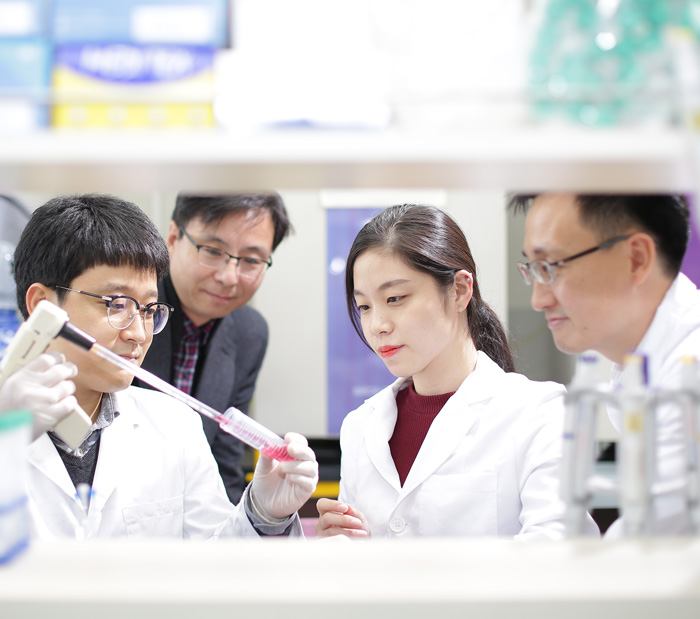
Chemical Engineering PARK, JAE HYUNG Prof.
Treatment of Intractable Disease with Ultrasound and Light-controlled Nanomedicine
Generally, chemotherapy is performed through administration of an anticancer drugs and irradiation. However, these treatments also affect normal cells as well as cancer cells, damaging the immune system in body. This is why photodynamic therapy or photothermal therapy, which can be treated only locally around cancer cells, is emerging as a new alternative for cancer therapy. Photodynamic therapy(PDT) is a treatment with photodynamic agents. The photosensitizer kills cancer cells with activated oxygen species that are activated by a laser of a specific wavelength. However, the photosensitizer remaining in the body was activated by visible light, resulting in the side effects to the normal tissues. Therefore, the patients who received the photodynamic therapy had to suffer the inconvenience of living in the dark room for a certain period of times. Photothermal therapy is a treatment using photothermal materials. The photothermal materials burns cancer cells by using heat generated by a near-infrared laser. This has attracted attention as a new treatment technique because of reduced side effects and suffering such as hair loss and so on. However, it has been difficult to utilize clinically photothermal materials because of the limitation of accurate delivery to the tumor sites. A research team led by Prof. Jae Hyung PARK has developed smart gold nanocapsules with excellent biocompatibility and tumor-targetability by applying gold to hyaluronic acid based nanoparticles. Particularly, hyaluronic acid on the surface of the capsules specifically binds to cancer cells, so that capsules in the body can actively find cancer cells. Furthermore, gold coated on the surface inhibits the indiscriminate activity of the photosensitizer caused by visible light in daily life when the nanocapsules releases heat and attacks cancer cells under laser irradiation. At this time, gold coated on the surface of the capsules is peeled off and the photosensitizer in the capsules selectively releases a large amount of reactive oxygen species to the tumor site to remove cancer cells. Prof. PARK said “This new gold nanocapsules will be used effectively and safely for cancer treatment and we will try to develop it as a core technology that can be used in clinical application.” This research was published in the world’s leading authoritative journal ACS Nano as of November 11th, with the title of “GoldNanoclustered Hyaluronan Nano-Assemblies for Photothermally Maneuvered Photodynamic Tumor Ablation.”
- No. 19
- 2018-07-05
- 1634
